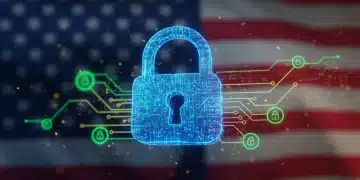Insider Threats: Identifying and Mitigating Risks to Your Organization

Insider threats involve risks from individuals within an organization who have access to sensitive information and systems; identifying these threats early and implementing effective mitigation strategies are crucial to prevent significant damage.
Navigating the complex landscape of cybersecurity requires a keen understanding of threats both external and internal. Mitigating insider threats, which arise from individuals within an organization who misuse their access to sensitive information, is critical to safeguarding your data and reputation. Let’s explore how to identify and mitigate risks before they cause irreversible damage.
Understanding the Landscape of Insider Threats
Insider threats represent a significant security challenge for organizations of all sizes. These threats can be malicious, negligent, or accidental, but the potential damage remains the same: data breaches, financial losses, and reputational harm. Recognizing the different types of insider threats and motivations behind them is the first step in creating a robust defense strategy.
Types of Insider Threats
Insider threats can manifest in various ways, depending on the intent and access level of the individual involved. Understanding these variations helps pinpoint vulnerabilities and tailor security measures effectively.
- Malicious Insiders: These individuals intentionally cause harm, often motivated by financial gain, revenge, or ideological reasons. They may steal sensitive data, sabotage systems, or sell confidential information to competitors.
- Negligent Insiders: Unintentional threats arise from employees who are careless with data or unaware of security protocols. This includes using weak passwords, falling for phishing scams, or leaving devices unattended.
- Accidental Insiders: These threats occur when employees make honest mistakes that compromise security. This could involve sending sensitive information to the wrong recipient or misconfiguring a system.
Motivations Behind Insider Threats
Understanding why an insider might pose a threat is crucial for early detection and prevention. Identifying potential triggers can help organizations proactively address the root causes of these risks.
- Financial Gain: The lure of money is a primary motivator. Insiders may steal and sell sensitive data, trade secrets, or intellectual property for personal profit.
- Revenge: Disgruntled employees seeking retribution for perceived wrongs may sabotage systems or leak confidential information to damage the company.
- Ideology: Insiders with strong ideological beliefs related to ethical or political issues might seek to leak information that exposes controversial or illegal activities.
Effectively managing insider threats requires a multifaceted approach that includes understanding their diverse nature and motivations. By categorizing potential insider threats and addressing the underlying causes, organizations can better protect themselves from costly security breaches.

Identifying Potential Insider Threats
Early detection is critical in mitigating the impact of insider threats. Implementing monitoring and analytical tools can help identify unusual behavior that may indicate malicious intent. By recognizing patterns and anomalies, organizations can intervene before significant damage occurs.
Monitoring Employee Activities
Monitoring employee activities is a core component of detecting insider threats. This involves tracking user behavior, access patterns, and data movement to identify suspicious actions.
- User Behavior Analytics (UBA): UBA tools analyze user behavior to establish a baseline of normal activity. Deviations from this baseline can flag potential insider threats.
- Data Loss Prevention (DLP): DLP systems monitor and control the movement of sensitive data, preventing unauthorized transmission or storage.
- Access Control Monitoring: Regular audits of user access rights help ensure that individuals only have access to the information and systems necessary for their job roles.
Recognizing Behavioral Indicators
Behavioral changes can be a strong indicator of potential insider threats. Being alert to these changes can help organizations intervene early and prevent malicious activities.
- Increased Work Hours: An employee spending excessively long hours at work, especially outside normal business hours, may be accessing sensitive data without authorization.
- Accessing Unnecessary Data: Employees who start accessing information unrelated to their job responsibilities may be planning to steal or misuse that data.
- Copying Large Amounts of Data: Sudden and unexplained copying or downloading of large amounts of data can indicate an intent to exfiltrate sensitive information.
Proactive identification of insider threats relies on a combination of diligent monitoring and behavioral analysis. By implementing robust detection mechanisms and staying vigilant for unusual behavior, organizations can minimize their vulnerability to internal security breaches.
Implementing a Robust Insider Threat Program
A robust insider threat program is crucial for systematically managing and mitigating risks posed by insiders. This program should include clear policies, ongoing training, and consistent enforcement to effectively protect sensitive information and assets.
Development of Clear Security Policies
Clear and comprehensive security policies are the backbone of any effective insider threat program. These policies should define acceptable behavior, data handling procedures, and consequences for violations.
Policy Components: Security policies must cover various aspects of data protection, including access controls, data classification, and incident response procedures. These policies should be easily accessible and understandable to all employees.
Regular Updates: Policies need to be reviewed and updated regularly to reflect changes in technology, business operations, and the threat landscape. This ensures that the policies remain relevant and effective.
Training Employees on Security Best Practices
Training is essential for educating employees about their roles in maintaining security and recognizing potential threats. Regular training sessions should cover various aspects of cybersecurity and insider threat awareness.
Awareness Programs: Training programs should focus on raising awareness of common insider threat tactics, such as phishing, social engineering, and data theft. Employees should be trained to identify and report suspicious activities.
Practical Exercises: Hands-on exercises, such as simulated phishing attacks and incident response drills, can reinforce training and improve employees’ ability to handle real-world situations.

By establishing clear security policies and providing regular, comprehensive training, organizations can create a security-aware culture that reduces the risk of insider threats. A well-informed workforce is better equipped to recognize and report suspicious activity, contributing to a stronger overall security posture.
Leveraging Technology to Mitigate Insider Threats
Technology plays a pivotal role in mitigating insider threats by providing tools for monitoring, analysis, and prevention. Implementing appropriate technological solutions can enhance an organization’s ability to detect and respond to potential insider threats quickly and effectively.
Data Loss Prevention (DLP) Systems
DLP systems are designed to detect and prevent sensitive data from leaving the organization’s control. These systems can monitor data in transit, at rest, and in use, providing comprehensive protection against data breaches.
Content Analysis: DLP tools use content analysis techniques to identify sensitive data based on predefined rules and patterns. This allows them to detect and block unauthorized copying or transmission of confidential information.
Endpoint Protection: DLP solutions can be deployed on endpoints, such as laptops and desktops, to monitor user activity and prevent data exfiltration through removable media, email, or cloud storage.
User and Entity Behavior Analytics (UEBA)
UEBA solutions use machine learning and behavioral analytics to identify anomalous user activities that may indicate insider threats. These tools can detect patterns that traditional security solutions might miss.
Behavioral Baselines: UEBA systems establish baselines of normal user behavior and then flag deviations from these baselines as potential threats. This helps organizations identify both malicious and negligent insiders.
Risk Scoring: UEBA tools assign risk scores to users based on their behavior, helping security teams prioritize investigations and focus on the most critical threats.
By utilizing DLP and UEBA technologies, organizations can significantly enhance their ability to detect and mitigate insider threats. These tools provide the visibility and intelligence needed to proactively protect sensitive data and systems from internal risks.
Responding Effectively to Insider Threat Incidents
A well-defined incident response plan is critical for effectively managing insider threat incidents. This plan should outline procedures for investigation, containment, and remediation, ensuring a coordinated and timely response to minimize damage.
Developing an Incident Response Plan
An incident response plan provides a structured approach to handling security incidents, including those involving insider threats. This plan should be documented, tested, and regularly updated to reflect current threats and organizational changes.
Key Components: The incident response plan should include clear roles and responsibilities, communication protocols, and procedures for incident detection, analysis, containment, eradication, and recovery.
Regular Testing: Conducting regular tabletop exercises and simulations can help identify weaknesses in the incident response plan and ensure that the team is prepared to handle real-world incidents.
Conducting Thorough Investigations
A thorough investigation is essential for understanding the scope and impact of an insider threat incident. This involves gathering evidence, interviewing witnesses, and analyzing data to determine the cause and extent of the breach.
- Evidence Collection: Collect and preserve all relevant evidence, including logs, emails, and file access records, to support the investigation.
- Interviews: Conduct interviews with relevant employees to gather additional information and perspectives on the incident.
- Data Analysis: Analyze the collected data to identify patterns, anomalies, and potential indicators of compromise.
Effective incident response is crucial for minimizing the impact of insider threats. By developing a comprehensive incident response plan and conducting thorough investigations, organizations can limit damage and prevent future incidents.
Building a Culture of Security Awareness
A strong security culture is essential for reducing the risk of insider threats. Building a culture where security is valued and understood throughout the organization fosters vigilance and encourages employees to take ownership of protecting sensitive information.
Promoting Open Communication
Open communication channels encourage employees to report suspicious activities without fear of retaliation. This fosters a collaborative environment where potential security threats are identified and addressed promptly.
Reporting Mechanisms: Establish clear and confidential reporting mechanisms for employees to report security concerns. This could include a hotline, email address, or online form.
Non-Retaliation Policy: Implement a strict non-retaliation policy to protect employees who report suspicious activities. This encourages employees to come forward with information without fear of repercussions.
Fostering a Security-First Mindset
Creating a security-first mindset involves integrating security considerations into all aspects of the organization’s operations. This requires ongoing education, reinforcement of security policies, and visible support from leadership.
Leadership Commitment: Leaders must demonstrate a strong commitment to security and communicate its importance to all employees. This sets the tone for a security-conscious culture.
Continuous Education: Provide ongoing education and awareness programs to reinforce security best practices and keep employees informed about emerging threats.
By promoting open communication and fostering a security-first mindset, organizations can build a culture that reduces the risk of insider threats. A security-aware workforce is more likely to identify and report suspicious activities, contributing to a stronger overall security posture.
| Key Point | Brief Description |
|---|---|
| 🚨 Threat Identification | Recognizing various types of insider threats and their motivations. |
| 🛡️ Security Policies | Developing clear and comprehensive policies for data protection. |
| 🧑🏫 Employee Training | Educating employees on security best practices and threat awareness. |
| 🔍 Incident Response | Planning for and effectively responding to insider threat incidents. |
Retractable FAQ Section
What are insider threats?
Insider threats are security risks originating from within an organization, involving employees, contractors, or partners who have access to sensitive data and systems. These individuals can unintentionally or maliciously compromise security.
How can I identify potential insider threats?
Look for behavioral indicators such as increased work hours, accessing unnecessary data, and copying large amounts of data. Implement monitoring tools like UBA to detect anomalous activities and patterns that may indicate malicious intent.
What is the role of technology in mitigating insider threats?
Technology, such as DLP and UEBA systems, plays a vital role. DLP prevents sensitive data from leaving the organization’s control, while UEBA uses machine learning to identify anomalous user behaviors.
What steps should I take when responding to an insider threat incident?
Develop an incident response plan that includes procedures for investigation, containment, and remediation. Collect evidence, conduct interviews, analyze data, and communicate effectively to minimize damage.
How can I create a culture of security awareness in my organization?
Promote open communication and foster a security-first mindset. Provide continuous education and awareness programs to reinforce security best practices and ensure employees understand their roles in protecting sensitive information.
An organization’s security posture is significantly influenced by its ability to manage insider threats effectively. By implementing proactive measures and fostering a culture of security awareness, businesses can greatly minimize their vulnerability to internal security breaches. Protecting against insider threats is a continuous process that requires constant vigilance and adaptation.
Read more content





